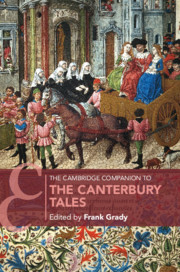Book contents
- The Cambridge Companion to The Canterbury Tales
- The Cambridge Companion to The Canterbury Tales
- Copyright page
- Contents
- Illustrations
- Contributors
- Preface
- Note on the Text
- Chronology
- Abbreviations
- 1 The Form of the Canterbury Tales
- 2 Manuscripts, Scribes, Circulation
- 3 The General Prologue
- 4 The Knight’s Tale and the Estrangements of Form
- 5 The Miller’s Tale and the Art of Solaas
- 6 The Man of Law’s Tale
- 7 The Wife of Bath’s Prologue and Tale
- 8 The Friar’s Tale and TheSummoner’s Tale in Word and Deed
- 9 Griselda and the Problem of the Human in The Clerk’s Tale
- 10 The Franklin’s Symptomatic Sursanure
- 11 The Pardoner and His Tale
- 12 The Prioress’s Tale
- 13 The Nun’s Priest’s Tale
- 14 Moral Chaucer
- 15 Chaucer’s Sense of an Ending
- 16 Postscript: How to Talk about Chaucer with Your Friends and Colleagues
- Further Reading
- Index
- Cambridge Companions to …
7 - The Wife of Bath’s Prologue and Tale
Published online by Cambridge University Press: 21 August 2020
- The Cambridge Companion to The Canterbury Tales
- The Cambridge Companion to The Canterbury Tales
- Copyright page
- Contents
- Illustrations
- Contributors
- Preface
- Note on the Text
- Chronology
- Abbreviations
- 1 The Form of the Canterbury Tales
- 2 Manuscripts, Scribes, Circulation
- 3 The General Prologue
- 4 The Knight’s Tale and the Estrangements of Form
- 5 The Miller’s Tale and the Art of Solaas
- 6 The Man of Law’s Tale
- 7 The Wife of Bath’s Prologue and Tale
- 8 The Friar’s Tale and TheSummoner’s Tale in Word and Deed
- 9 Griselda and the Problem of the Human in The Clerk’s Tale
- 10 The Franklin’s Symptomatic Sursanure
- 11 The Pardoner and His Tale
- 12 The Prioress’s Tale
- 13 The Nun’s Priest’s Tale
- 14 Moral Chaucer
- 15 Chaucer’s Sense of an Ending
- 16 Postscript: How to Talk about Chaucer with Your Friends and Colleagues
- Further Reading
- Index
- Cambridge Companions to …
Summary
This chapter seeks to justify and explain the Wife of Bath’s prominence among the Canterbury pilgrims as the representative of Chaucer’s powers of representation and as the anchor of the debate on marriage witnessed across a number of tales. As a source of dramatic intensity and thematic richness, the Wife offers an argumentative and autobiographical anti-clerical prologue and a redemptive romance that complicate received ideas of women’s value in marriage. She demonstrates the Wife’s stereotypically “feminine” foibles and her radically feminist thought, which turn our neat conceptions of masculine and feminine, active and passive, spiritual and worldly, on their head. The chapter argues for the Wife’s disruptive power in the Canterbury Tales.
Keywords
- Type
- Chapter
- Information
- The Cambridge Companion to The Canterbury Tales , pp. 105 - 120Publisher: Cambridge University PressPrint publication year: 2020
- 1
- Cited by

